I’m excited to share my top picks for the 15 best stud sensors that’ll help you uncover hidden gems during your renovations. Whether you’re a DIY enthusiast or a seasoned pro, there’s a stud finder to suit your needs. From the highly accurate Franklin Sensors ProSensor M210 to versatile options like the USTUDCHY 5 in 1 Electronic Wall Scanner, you’ll find tools that guarantee safety and precision. Stick around to discover other essential features and models!
Key Takeaways
- Discover top stud finders like Franklin Sensors ProSensor M210 and USTUDCHY 5 in 1 for accurate detection during renovations.
- Evaluate features such as multiple scanning modes, user-friendly displays, and safety mechanisms for optimal performance.
- Consider pros and cons of each model, focusing on detection accuracy, battery life, and ease of use.
- Read user feedback to gauge reliability and effectiveness for various home renovation projects.
- Prioritize models that offer ergonomic designs, portability, and clear visual indicators for enhanced usability.
Franklin Sensors ProSensor M210 Stud Finder
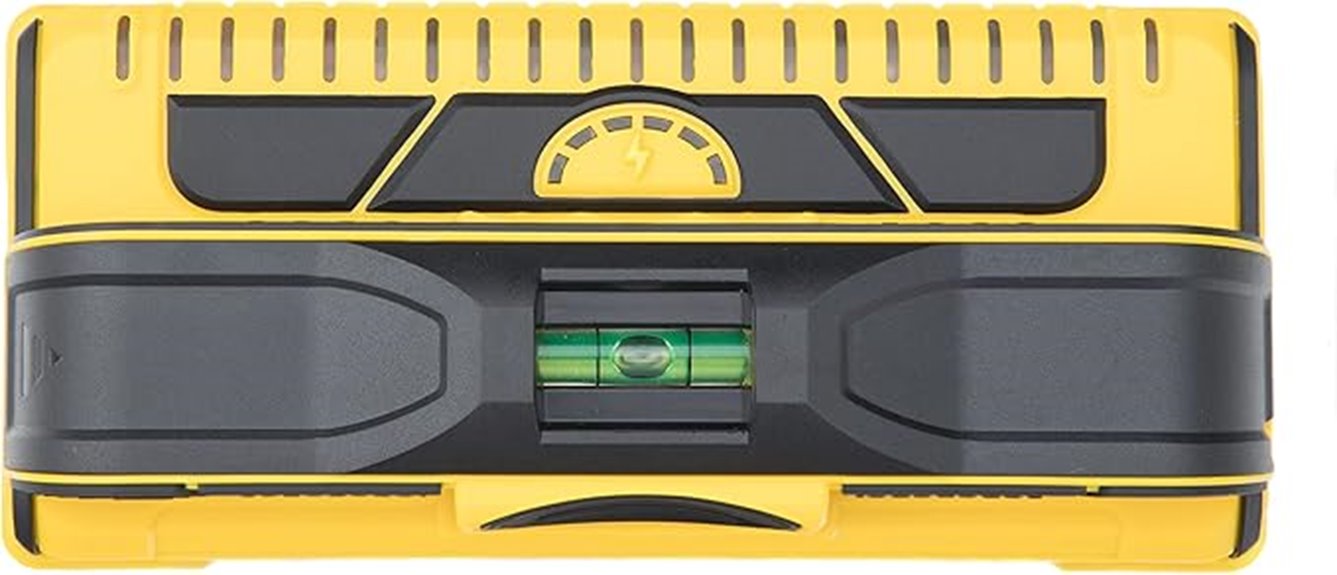
If you’re tackling a renovation project, the Franklin Sensors ProSensor M210 Stud Finder is a standout choice for both professionals and DIY enthusiasts alike. With its 13 patented sensors, it accurately identifies studs and live wires, giving you peace of mind while you work. The wide LED display makes it easy to spot edges and centers, and the deep scan capability reaches up to 1.7 inches. I love its ergonomic design, which feels comfortable in hand, and the built-in pencil holder is a thoughtful touch. Despite being slightly bulkier, its reliability and performance make it worth every penny for my projects.
Best For: The Franklin Sensors ProSensor M210 Stud Finder is best for both professionals and DIY enthusiasts looking for a reliable and accurate stud detection tool for their renovation projects.
Pros:
- Accurate detection of studs and live wires thanks to 13 patented sensors and multi-sense technology.
- Wide LED display provides clear visual indicators for stud edges and centers, enhancing usability.
- Ergonomic design and built-in features like a pencil holder make it convenient and comfortable to use.
Cons:
- Some users find it bulky for tight spaces, which may hinder its usability in certain situations.
- Requires a continuous button press during scanning, which can be cumbersome over extended use.
- Occasional inconsistencies in live wire detection have been reported by some users.
Stud Finder – 5 in 1 Electronic Wall Scanner

The USTUDCHY 5 in 1 Electronic Wall Scanner is an essential tool for anyone tackling home renovations, whether you’re a seasoned professional or a weekend DIY warrior. With advanced sensors, it accurately detects metal pipes, studs, and AC wires in five different modes. The large LCD display makes it easy to pinpoint objects, while the ergonomic handle guarantees comfort during use. I love the safety features that prevent accidental drilling into live wires. Plus, backed by a 60-day guarantee, it’s reliable and effective. Users rave about its accuracy, making it a must-have for your next project!
Best For: Homeowners, DIY enthusiasts, and professionals looking for a reliable tool to detect studs, metal pipes, and AC wires during renovations.
Pros:
- Accurate detection of multiple materials with advanced sensor technology.
- Large LCD display and ergonomic design enhance user experience and comfort.
- Safety features prevent accidental drilling into live wires, ensuring user safety.
Cons:
- Occasional false readings on textured surfaces may lead to confusion.
- May require calibration for optimal performance in certain conditions.
- Some users might find it bulky for extended use compared to simpler models.
HANMATEK SF3 6-in-1 Stud Finder for Wood, Metal, and Live AC Wires Detection

For anyone tackling home renovations or DIY projects, the HANMATEK SF3 6-in-1 Stud Finder stands out with its impressive ability to detect wood studs, metals, and live AC wires all in one device. I love its dual modes for wood detection, reaching depths of up to 38mm. It effortlessly locates ferrous and non-ferrous metals too. The user-friendly LCD display and audible alerts make it easy to use, even for beginners. Plus, with a battery life of about two hours, it’s reliable during those long projects. Overall, this stud finder is a fantastic addition to any DIY toolkit!
Best For: Homeowners and DIY enthusiasts looking for an efficient and versatile tool to locate studs, metals, and live wires during renovation projects.
Pros:
- Effective for locating wood studs, ferrous and non-ferrous metals, and live AC wires.
- User-friendly design with a clear LCD display and audible alerts, suitable for beginners.
- Dual modes for wood detection allow for varying depths, enhancing accuracy.
Cons:
- Variable sensitivity may require adjustments during use.
- Needs recalibration after short breaks, which can interrupt workflow.
- Battery life is limited to approximately 2 hours, which may necessitate frequent replacements during long projects.
Stud Finder Wall Scanner, 5 in 1 Multifunction Locator
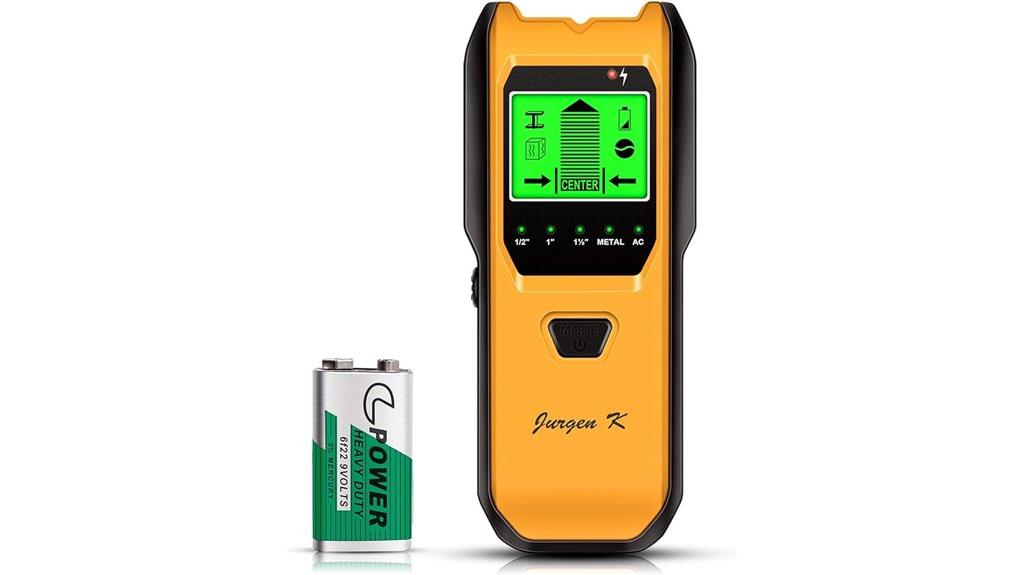
Looking for a reliable tool to enhance your renovation projects? The Jurgen K TH530 Stud Finder Wall Scanner is a game changer. This 5 in 1 multifunction locator quickly detects wood, metal, and live AC wires, making it perfect for various wall types. Weighing just 10.2 ounces, it’s easy to handle, and the HD LCD screen provides clear readings. With its intuitive design and non-slip grip, it’s user-friendly for everyone. Many users rave about its accuracy and build quality, although some mention calibration is key. Overall, it’s a fantastic investment for DIY enthusiasts and professionals alike!
Best For: DIY enthusiasts and professionals seeking a reliable tool for detecting wood, metal, and live AC wires in various wall types.
Pros:
- Accurate Detection: Utilizes multi-sensing technology for precise location of studs, wires, and pipes.
- User-Friendly Design: Features an HD LCD screen, non-slip grip, and intuitive button layout for ease of use.
- Versatile Functionality: Works effectively on multiple wall surfaces, making it suitable for diverse renovation projects.
Cons:
- Calibration Required: Some users report the need for careful calibration to achieve optimal performance.
- Inconsistent Detection: A few reviews mention variability in wire and metal detection accuracy.
- Learning Curve: New users may need to refer to the manual for understanding all functions effectively.
Franklin Sensors ProSensor M150 Stud Finder with Live Wire Detection
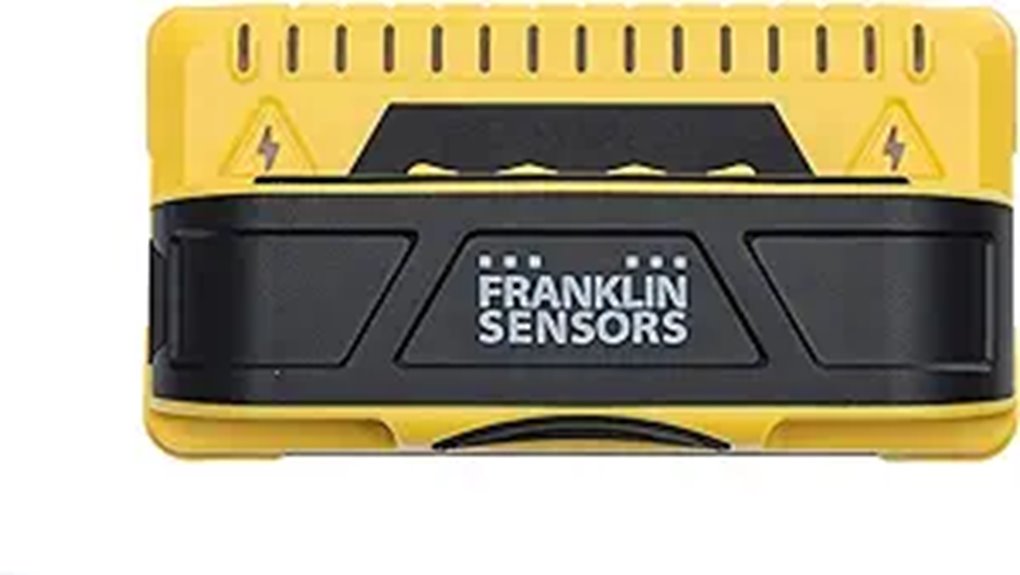
When it comes to renovations, having a reliable stud finder like the Franklin Sensors ProSensor M150 is essential for both DIY enthusiasts and professionals. With nine sensors, it offers superior accuracy compared to conventional models. It easily detects studs up to 1.5 inches deep, working seamlessly through drywall and other materials. I love how it displays both the center and edges of studs simultaneously, making my tasks more efficient. Plus, the live wire detection adds safety. Users rave about its ease of use, and with an impressive 4.5-star rating, it’s clear the ProSensor M150 is a top choice for reliable stud finding.
Best For: DIY enthusiasts and professionals seeking a reliable and accurate stud finder for various renovation projects.
Pros:
- High accuracy due to nine sensors, reducing the chances of misreads.
- Easy to use with a simple operation that does not require calibration.
- Safety features including live wire detection for added peace of mind.
Cons:
- Live wire detection may not be as precise as stud detection.
- Requires 2 AAA batteries which are not included in the package.
- Some users may find it less effective on thicker materials beyond its detection depth.
Stud Finder Wall Scanner, 5 in 1 Electronic Stud Detector
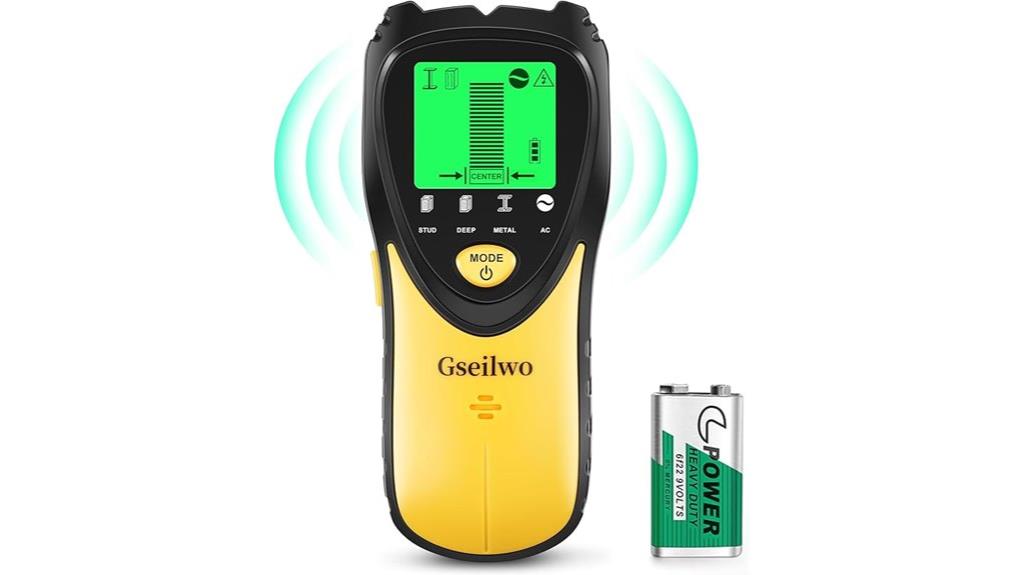
The Gseilwo Stud Finder Wall Scanner stands out as an essential tool for DIY enthusiasts and professionals alike, thanks to its impressive 5 in 1 functionality. With modes for detecting wood, metal, AC wires, joists, and pipes, I can easily locate what I need. Its LCD display with audio alarms guarantees I won’t miss anything. I appreciate its accuracy—better than 95% of other stud finders. Plus, it’s durable and safe, indicating live wires to prevent accidents. Weighing just 8.4 ounces, this compact device is convenient, making renovations a breeze. I highly recommend it for anyone tackling home improvement projects.
Best For: DIY enthusiasts and professionals looking for a reliable and accurate stud finder for home improvement projects.
Pros:
- Highly accurate with detection capabilities surpassing 95% of other stud finders on the market.
- Multi-functional with 5 scanning modes for diverse applications including wood, metal, AC wires, joists, and pipes.
- Durable design featuring shock and dust resistance, ensuring longevity and performance in various wall materials.
Cons:
- Limited depth detection for some materials, which may not suit all projects requiring deeper scans.
- Battery-powered operation might require occasional battery replacements, adding to maintenance.
- Learning curve for new users who may need time to familiarize themselves with all the scanning modes and features.
Franklin Sensors ProSensor MAX Stud Finder
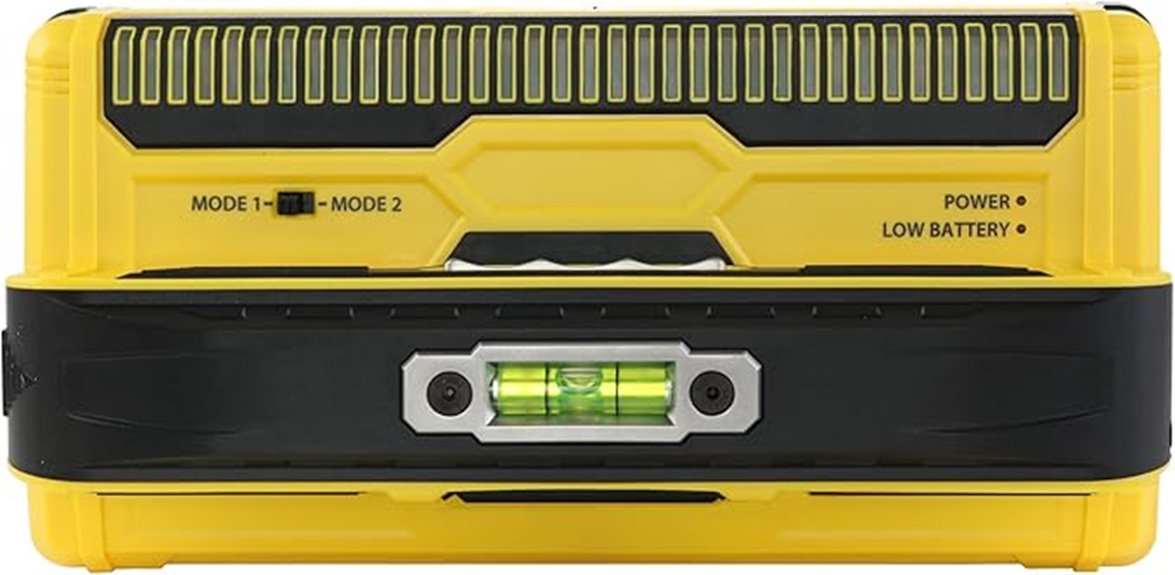
For DIY enthusiasts and professionals tackling renovations, the Franklin Sensors ProSensor MAX Stud Finder stands out with its impressive 13 sensors, making it one of the most accurate tools on the market. It easily detects wood and metal studs, even through plaster and tile, with a max detection depth of 2 1/2 inches. I love the dual detection modes and the way it shows the full width of studs with precision LEDs. Plus, there’s no calibration needed—just place it on the wall and press a button. With a high customer rating, it’s a reliable choice for any renovation project.
Best For: DIY enthusiasts and professionals looking for a reliable and accurate stud finder for renovation projects.
Pros:
- Highly accurate with 13 sensors, allowing for precise stud detection behind various materials.
- Easy to use with no calibration needed; simply press a button to start scanning.
- Positive customer feedback highlights its effectiveness and reliability, making it a recommended choice.
Cons:
- Some users have reported difficulties in detecting electrical wiring, which may limit its functionality.
- The ProSensor MAX is considered bulky by some, leading to mixed opinions about its size versus performance.
- A carrying case and included batteries are not provided, which could enhance the overall value.
Stud Finder Wall Scanner Detector – 5 in 1 Electronic Locator
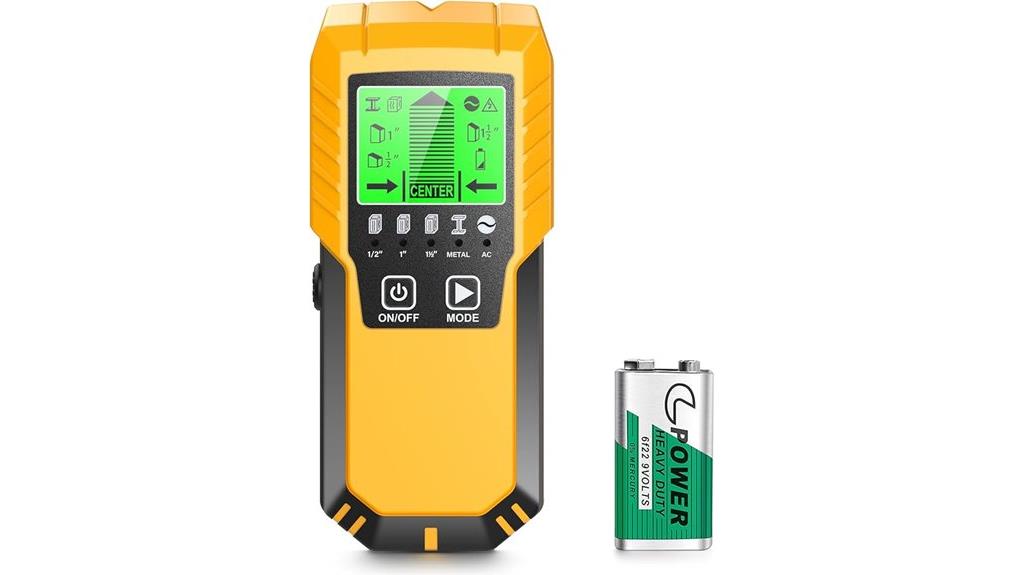
Looking for a reliable tool to help you avoid costly mistakes during renovations? The Stud Finder Wall Scanner Detector is a game-changer. This 5 in 1 electronic locator detects metal, wood studs, joists, pipes, and live AC wires with ease. With five scanning modes, including deep scan capability, it guarantees you won’t accidentally drill into something dangerous. The bright backlight LCD and audio alerts keep you informed, while its shock and dust-resistant design adds durability. Despite some mixed reviews on accuracy, I find it invaluable for hanging heavy objects safely, making it a must-have for any renovation project.
Best For: DIY enthusiasts and homeowners looking to safely and accurately locate studs, pipes, and live wires during renovations.
Pros:
- Versatile Functionality: Detects a variety of materials including metal, wood, and live AC wires.
- User-Friendly Display: Features a bright backlight LCD and audio alerts for easy operation.
- Durable Design: Shock and dust-resistant, ensuring longevity and reliability.
Cons:
- Mixed Accuracy Reports: Some users experience inconsistencies in detection accuracy.
- Calibration Challenges: A few users mention difficulties in calibrating the device properly.
- Limited Battery Life: Battery-powered operation may require frequent replacements for extensive projects.
Franklin Sensors ProSensor M90 Stud Finder
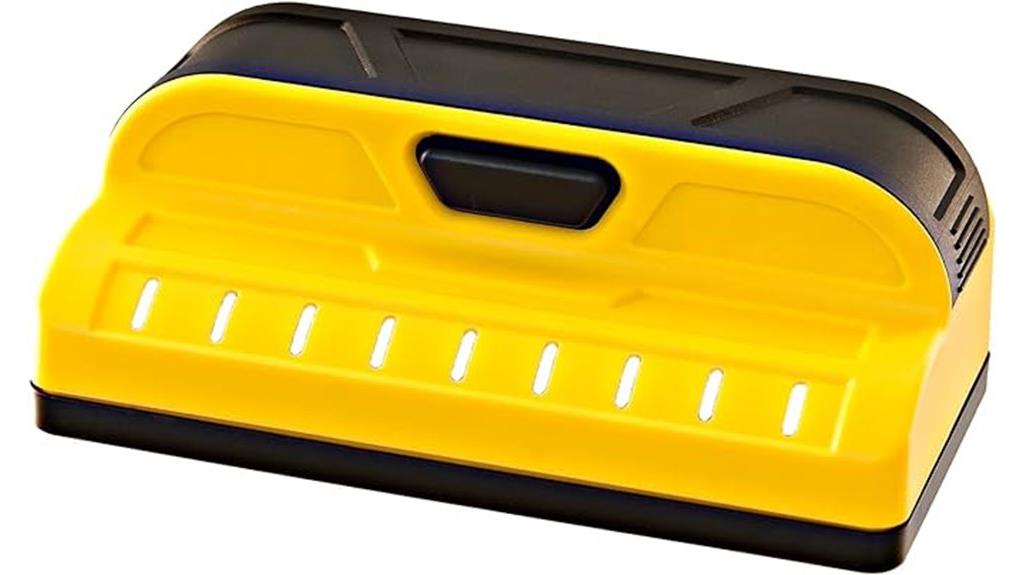
With its nine sensors, the Franklin Sensors ProSensor M90 Stud Finder stands out as an essential tool for anyone tackling home renovations. This device easily detects wood and metal studs up to 1.5 inches deep, displaying the center and edges of studs simultaneously. I love that it requires no calibration—just press and hold to scan! Its ergonomic design makes it comfortable to use, and it’s effective on both drywall and plaster. With an impressive average rating of 4.4 stars, it’s a reliable choice for hanging items or mounting shelves. Overall, it’s a user-friendly tool that I highly recommend.
Best For: Home improvement enthusiasts and DIYers looking for a reliable and easy-to-use stud finder for various projects.
Pros:
- High accuracy with nine sensors, providing precise readings for both wood and metal studs.
- No calibration required, making it user-friendly and quick to operate.
- Ergonomic design enhances comfort during lengthy use on projects.
Cons:
- Some users have reported issues with individual units, indicating potential quality control concerns.
- Uses AAA batteries that are not rechargeable, which may be inconvenient for some users.
- Limited detection depth of 1.5 inches may not suffice for all wall types or installations.
Stud Finder Wall Scanner 5 in 1 Multifunctional Detector
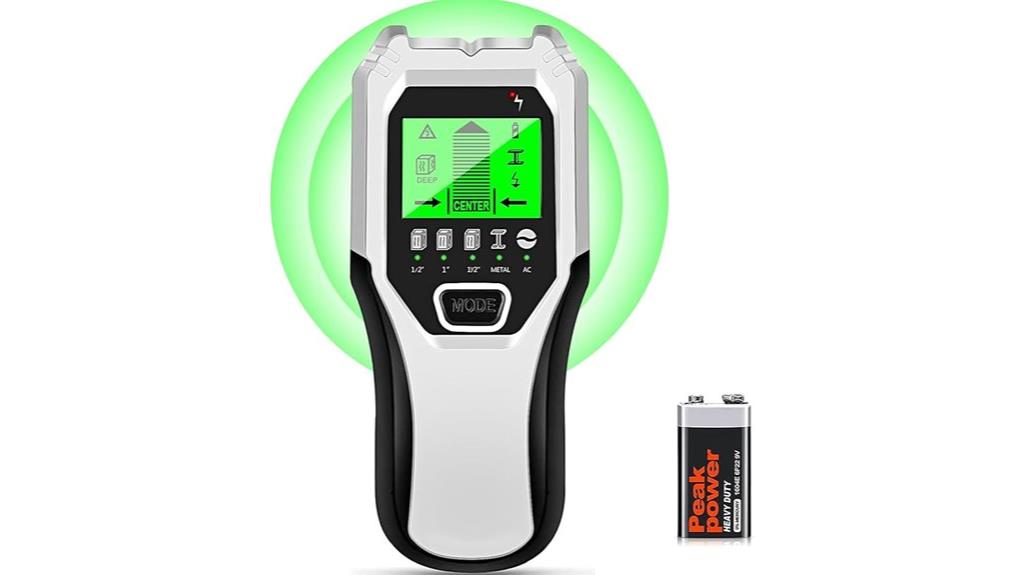
The Stud Finder Wall Scanner 5 in 1 Multifunctional Detector is perfect for anyone tackling DIY renovations or home improvement projects. With its upgraded sensor chips, I’ve found it incredibly accurate for locating wood, metal, and live AC wires. The HD LCD display makes it easy to read, and the audible alarm is a fantastic feature for ensuring safety. It offers five scan modes, detecting depths up to 60mm, which is ideal for various materials. I appreciate the user-friendly design and quick delivery, plus it even comes with batteries included. Overall, it’s a reliable tool for any homeowner.
Best For: Homeowners and DIY enthusiasts looking for a reliable tool to locate studs, metal pipes, and live wires accurately.
Pros:
- Accurate detection of wood, metal, and AC wires due to upgraded sensor technology.
- User-friendly design with an easy-to-read HD LCD display and clear audible alarms for safety.
- Multiple scan modes with deep detection capabilities, making it versatile for various home improvement tasks.
Cons:
- Limited depth detection for certain materials may not meet the needs of all users.
- May require practice to master all the features and modes for optimal use.
- Battery-operated, which means users need to monitor battery life for consistent performance.
Stud Finder Wall Scanner – 5 in 1 Electronic Stud Detector
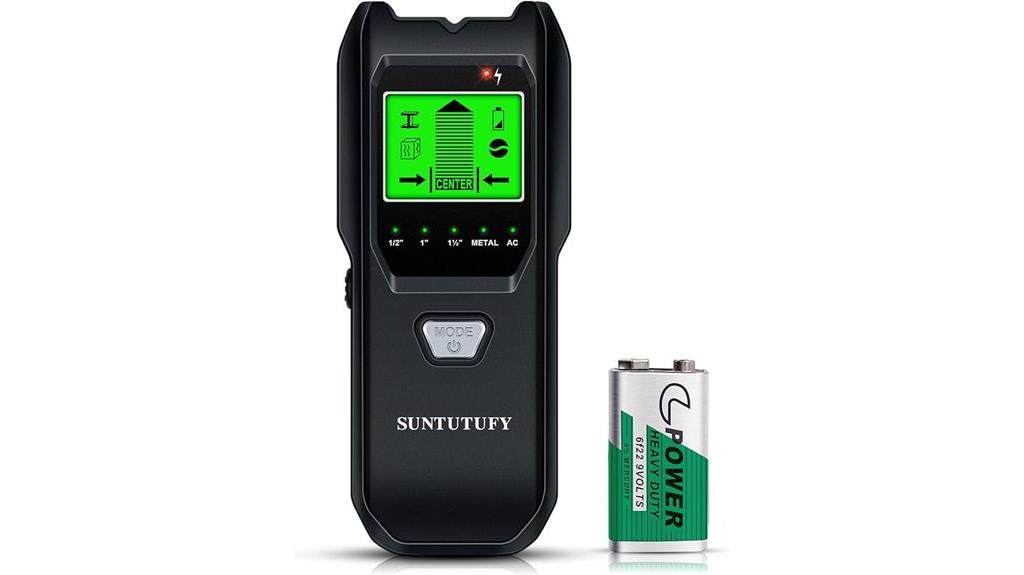
If you’re a DIY enthusiast or a homeowner tackling renovations, the Stud Finder Wall Scanner – 5 in 1 Electronic Stud Detector is an essential tool for your toolkit. This sleek, frosted black device weighs just 9.6 ounces and offers five detection modes for studs, metals, and live wires. With automatic calibration and an upgraded LCD display, it guarantees accuracy, even in dim light. I love its audio alarm feature that alerts me when I’m near a target. Plus, the positive reviews highlight its user-friendly design, making it a reliable choice for any project. Don’t forget Amazon’s 30-Day Return Guarantee for peace of mind!
Best For: DIY enthusiasts and homeowners looking for a reliable tool to locate studs, pipes, and live wires during renovations.
Pros:
- Easy to use with a user-friendly design, suitable for various projects.
- Accurate detection capabilities with five modes and automatic calibration.
- Lightweight and compact, making it convenient to handle and store.
Cons:
- Some users reported issues with accuracy in certain situations.
- May require batteries, which need to be replaced periodically.
- Limited depth detection for certain materials may affect usability in specific scenarios.
Stud Finder Wall Scanner & Laser Distance Meter
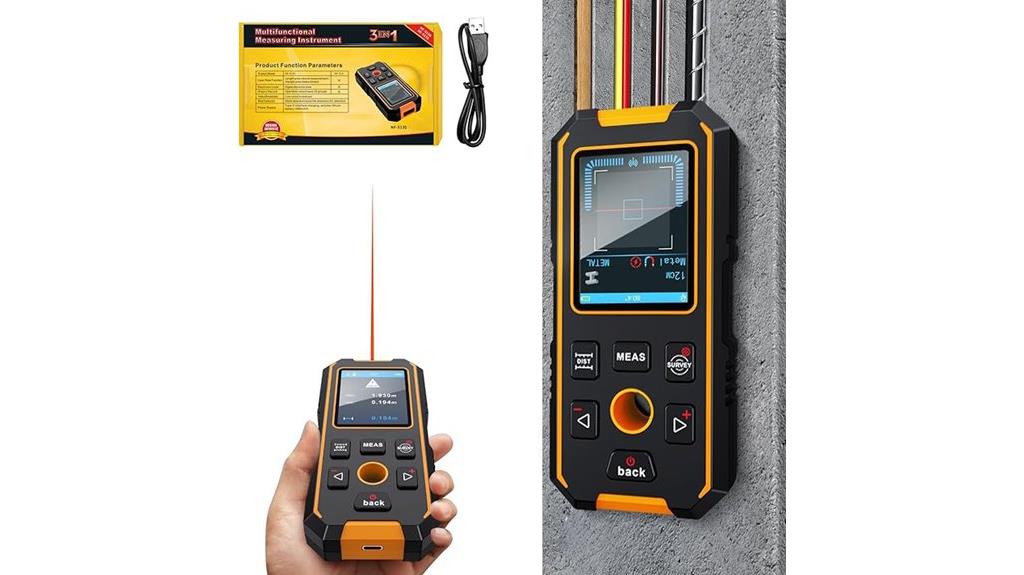
For anyone tackling home renovations, the Stud Finder Wall Scanner & Laser Distance Meter is an invaluable tool that streamlines the process of locating hidden structures behind walls. With its ability to detect metals, cables, and wooden beams, I find it essential for ensuring I avoid costly mistakes. It measures up to 130FT and offers various modes for different materials, making it versatile. The HD LCD display shows distance and signal strength, while the built-in voice function alerts me as I get closer to my target. Plus, it stores 50 measurements, which helps when I need to compare results.
Best For: DIY enthusiasts and professionals looking for an efficient tool to locate hidden structures and measure distances accurately during home renovations.
Pros:
- High accuracy in detecting studs, metals, and cables, even on plaster walls.
- Versatile measurement capabilities with up to 12 modes and a range of up to 130FT.
- Convenient data storage for up to 50 measurement results for easy comparison.
Cons:
- Some users may experience a learning curve with the display interface.
- Non-removable lithium battery could pose a problem when it reaches the end of its life.
- The durability of the device might raise concerns among some users.
5 IN 1 Stud Finder Wall Scanner
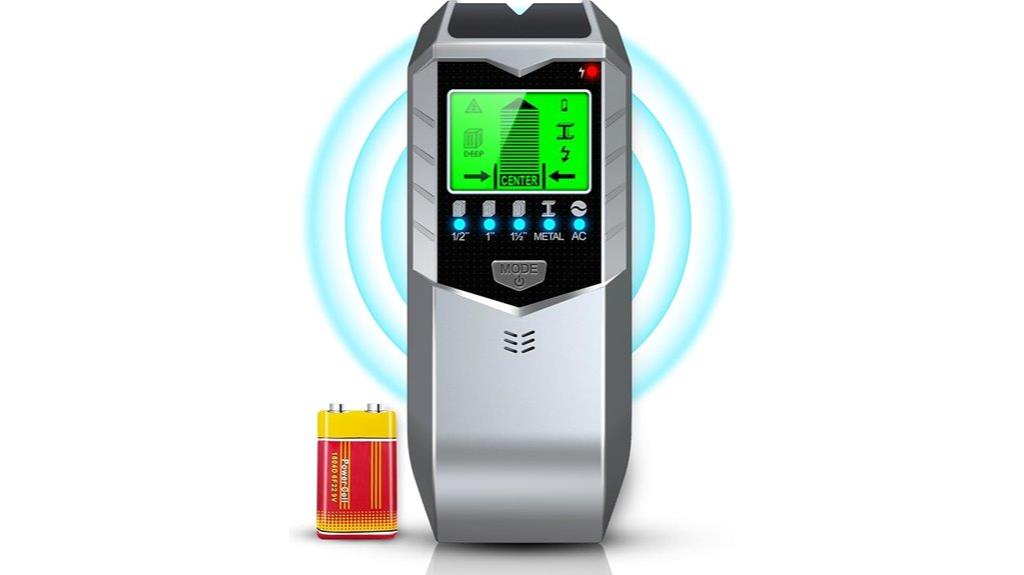
Searching for a reliable tool to locate hidden structures in your walls? The 5 IN 1 Stud Finder Wall Scanner by FLPY is a must-have for any DIY enthusiast or professional. With its precision-engineered chip, it quickly detects metal, wood, and live AC wires, offering multiple scanning modes for different depths. The upgraded backlight LCD guarantees visibility in dim light, and the one-button design makes operation a breeze. Plus, it’s lightweight and battery-powered, making it portable for any project. With a solid 4.4-star rating, it’s clear this tool is a hidden gem for any renovation.
Best For: The 5 IN 1 Stud Finder Wall Scanner is best for DIY enthusiasts and professionals looking to safely locate hidden structures in walls, floors, and ceilings.
Pros:
- Easy to Use: The one-button design simplifies operation for users of all skill levels.
- Versatile Detection Modes: Offers multiple scanning modes for various depths, making it suitable for different materials.
- Clear Display: The upgraded backlight LCD ensures visibility in low-light conditions.
Cons:
- Calibration Required: Initial calibration may be necessary before each use, which can be inconvenient.
- Battery Life Concerns: Some users report issues with battery longevity.
- Limited Warranty Information: Additional warranty details may not be readily available without request.
Stud Finder Wall Scanner with HD LCD Display
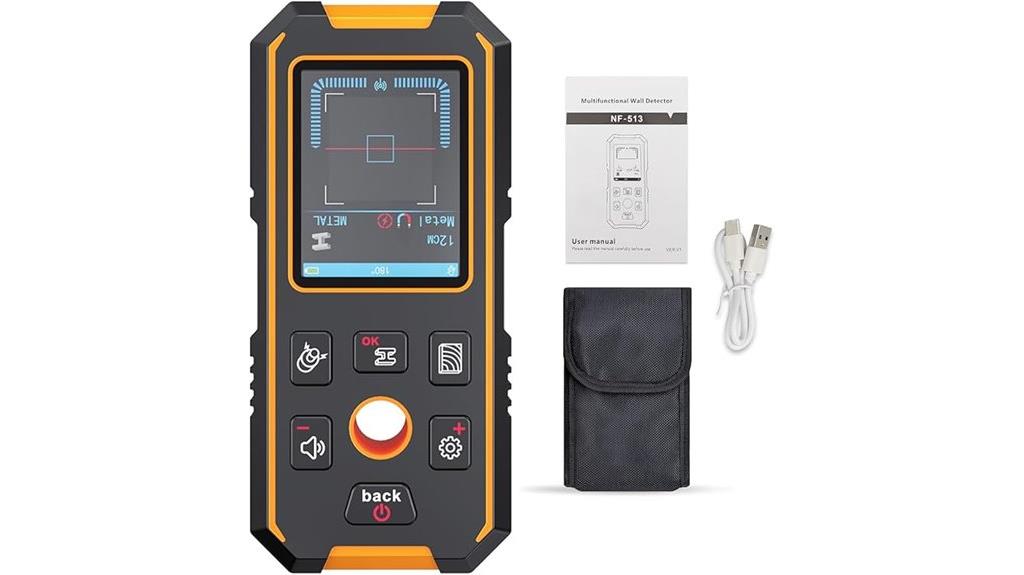
The Stud Finder Wall Scanner with HD LCD Display stands out for its three detection modes, making it an ideal choice for DIY enthusiasts and professionals tackling renovations. I love how it detects wood, metal, and live wires with impressive depth capabilities. The upgraded smart sensor and clear HD display enhance accuracy, while the loud audio alarm keeps me informed. However, I found the learning curve a bit tricky, especially with sensitivity settings. Although some users reported issues with screen orientation and AC wire detection, overall, it’s a handy tool that’s worth familiarizing yourself with for reliable results.
Best For: DIY enthusiasts and professionals tackling renovations who need reliable detection of materials within walls, ceilings, and floors.
Pros:
- Multiple detection modes for wood, metal, and live wires enhance versatility.
- Upgraded smart sensor and HD display improve accuracy and usability.
- Built-in rechargeable battery offers convenience and portability.
Cons:
- Learning curve associated with sensitivity settings may frustrate some users.
- Screen orientation and button placement can be inconsistent.
- Mixed experiences reported with the accuracy of AC wire detection.
Stud Finder Wall Scanner – 5 in 1 Electronic Stud Detector
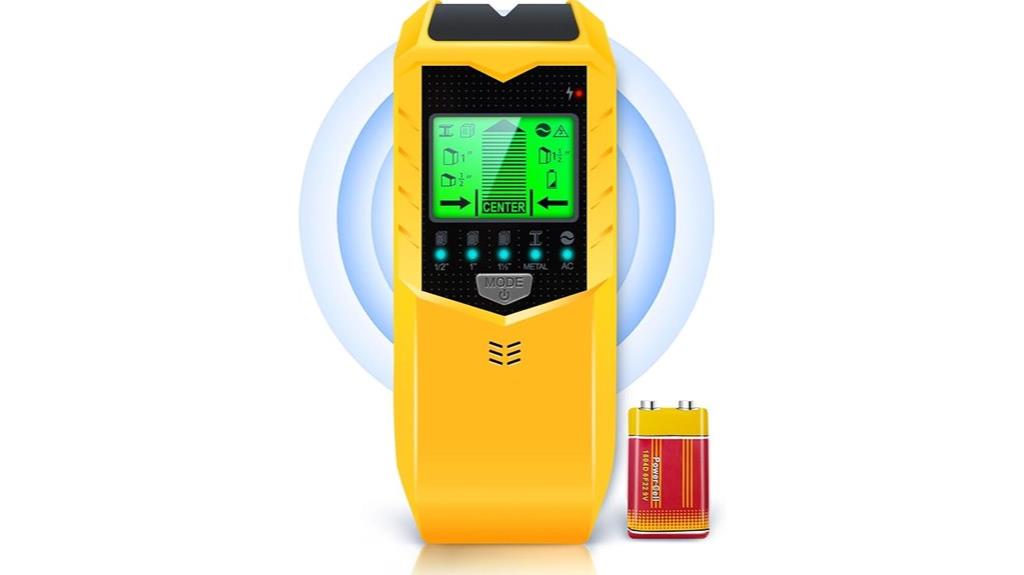
If you’re tackling a renovation project, the Stud Finder Wall Scanner—Upgrade 5 in 1 Electronic Stud Detector—might just be your new best friend. This handy tool detects wood, metal, pipes, joists, and AC wires, making it incredibly versatile. With five scanning modes, it can handle various wall materials up to 2.36 inches deep. I love its advanced sensor technology, which guarantees accuracy, plus the audio alarm that alerts me when I’m near a target. Its durable, user-friendly design with an LCD display is perfect for low-light conditions. Whether you’re a pro or DIY enthusiast, this tool’s a must-have!
Best For: DIY enthusiasts and professionals looking for a reliable tool to detect hidden materials in walls, floors, and ceilings.
Pros:
- Versatile detection capabilities for wood, metal, pipes, joists, and AC wires with five scanning modes.
- High accuracy due to advanced sensor technology and audio alarms for target detection.
- User-friendly design featuring an LCD display and durable construction suitable for low-light conditions.
Cons:
- Some users reported issues with AC detection sensitivity, which may affect performance.
- Requires calibration before use, which may be an extra step for some users.
- Limited depth detection for certain materials, potentially restricting use in thicker walls.
Factors to Consider When Choosing Stud Sensors for Renovations
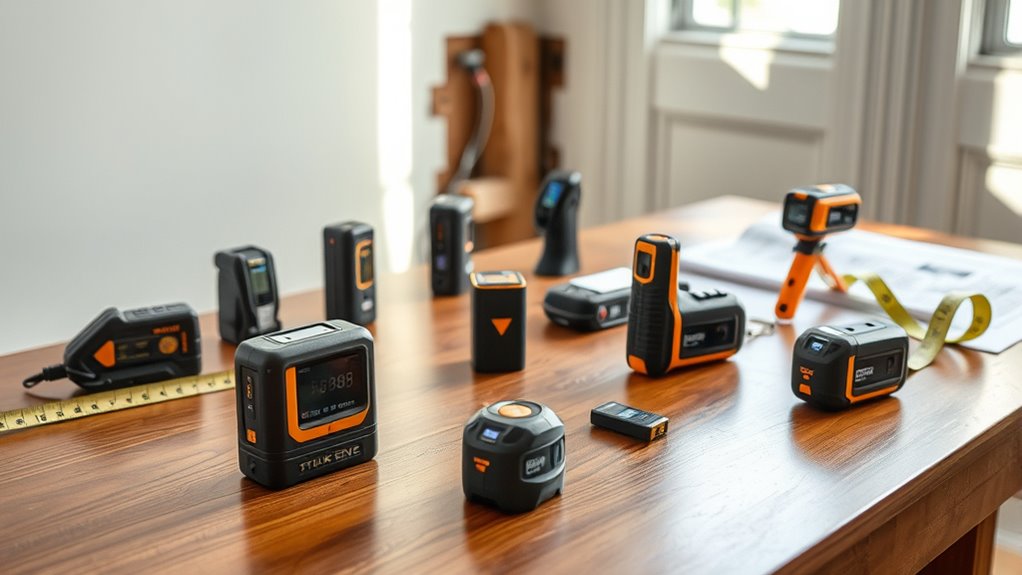
When I choose a stud sensor for renovations, I focus on several key factors. Detection accuracy and scan depth are essential, but I also appreciate user-friendly features and safety mechanisms. Plus, having multi-functionality can really enhance the overall experience and efficiency of my projects.
Detection Accuracy Levels
Choosing the right stud sensor for your renovation project hinges on detection accuracy levels. I’ve found that advanced models with 9 to 13 sensors greatly outperform conventional ones that utilize only 1 or 2. These higher-end devices can detect both the edges and centers of studs simultaneously, which is essential for precise drilling and installation. Safety is another factor; some sensors feature live wire detection, though be wary—performance can vary. I also appreciate user-friendly models that require no calibration, allowing for quick and accurate readings. When you’re investing in a stud sensor, consider these accuracy factors carefully to guarantee your renovation goes smoothly and safely.
Scan Depth Capabilities
Detection accuracy levels are just one part of the equation; scan depth capabilities play an equally important role in selecting the right stud sensor for your renovation. Different models offer varying scan depths, with some detecting through materials up to 2.5 inches deep, perfect for thicker walls. Typically, wood stud detection ranges from 1.5 to 2 inches, while metal detection can reach up to 2.36 inches for both ferrous and non-ferrous metals. Additionally, live wire detection often works effectively up to 2 inches deep, enhancing safety during your project. Advanced stud finders employ multiple sensors for improved accuracy, allowing you to identify stud edges and centers simultaneously. Always consider your renovation’s specific depth requirements to choose the best stud finder.
User-Friendly Features
Five essential user-friendly features can make a significant difference in your experience with stud sensors during renovations. First, look for ergonomic designs and non-slip handles to enhance comfort during prolonged use. Next, a large, backlit LCD display is vital for reading detection results easily, especially in low-light conditions. I also recommend choosing models with audio alarms that alert you when you’re near the edge or center of a detected object; it provides instant feedback. Additionally, opt for stud sensors that require no calibration, allowing you to dive right into your project. Finally, consider tools with multiple scanning modes to accurately detect various materials like wood, metal, and live wires, ensuring versatility for all your renovation tasks.
Safety Mechanisms Included
When you’re tackling renovations, guaranteeing safety should be your top priority, and stud sensors can help with that. Many stud sensors include live wire detection, alerting you to electrical wires up to 2 inches deep. This feature greatly reduces the risk of accidentally drilling into live wires or pipes. Look for models with a wire warning indicator that activates in different scanning modes for added protection. Additionally, audio alarms beep when you’re near the edge or center of detected materials, giving you immediate feedback. Choosing durable, shock-resistant, and dust-resistant devices guarantees they withstand tough job site conditions. With advanced sensor technology, you’ll get improved accuracy, minimizing false readings and promoting safer drilling practices throughout your renovation project.
Multi-Functionality Options
After ensuring safety with the right features in stud sensors, it’s time to contemplate how versatile these tools can be. Multi-functionality is a game changer for any renovation project. I love that many modern stud finders can detect wood and metal studs, live AC wires, and even pipes—making them invaluable. With various scanning modes like deep scan and metal scan, I can tailor detection based on my specific needs. Some advanced models even handle materials up to 2.5 inches thick, which is great for different wall structures. Plus, features like audible alarms and LCD displays provide real-time feedback, enhancing precision. Overall, having a versatile stud sensor greatly improves safety and efficiency during home improvement tasks.
Build Quality and Durability
Choosing the right stud sensor is essential for a successful renovation, especially when considering its build quality and durability. I always look for models made from shock-resistant and dust-resistant plastics; these materials can really take a beating on the job site. It’s also wise to check the protection ratings—IP54 or IP66 indicate solid resistance to dust and water, which is a plus for durability. I’ve noticed that heavier models often use more robust materials, while lighter ones might sacrifice durability for portability. Ergonomic designs not only improve comfort but also hint at thoughtful construction. Finally, a good warranty can reassure you about the product’s longevity, reflecting the manufacturer’s confidence in its build quality.
Frequently Asked Questions
How Do I Calibrate My Stud Sensor Before Use?
To calibrate my stud sensor before use, I always start by placing it flat against the wall. I then turn it on and wait for the indicator light to stabilize. Once that happens, I slowly slide the sensor horizontally along the wall until it detects a stud. If I’m unsure about the reading, I’ll reposition it and recalibrate. This guarantees I get the most accurate readings for my projects!
Can Stud Sensors Detect Pipes or Wires Behind Walls?
When I first started hanging shelves, I felt like a treasure hunter, excited to find hidden gems behind the wall. Stud sensors are great for detecting studs, but they can also pick up pipes or wires. I once learned the hard way that not all sensors are created equal; some missed the electrical wiring. Always check your sensor’s specifications to guarantee it can help you avoid those sneaky surprises during your projects!
What Is the Average Battery Life of These Stud Sensors?
When I first got my stud sensor, I wondered about its battery life. On average, these devices last anywhere from 6 months to a couple of years, depending on usage and the type of batteries they require. I’ve found that using it sparingly can extend its life. It’s always a good idea to keep a spare set of batteries handy, just in case you need to tackle any unexpected projects around the house!
Are There Specific Features to Look for in a Stud Sensor?
When I look for a stud sensor, I focus on a few key features. First, I want a sensor that can detect different materials, like wood and metal. An easy-to-read display is essential, too; I like knowing exactly where the studs are. A deep scan mode can be helpful for thicker walls, and if it has a built-in level, that’s a bonus. Battery life is important, so I check that as well.
How Do I Know if My Stud Sensor Is Malfunctioning?
I know it’s easy to think your stud sensor is always reliable, but sometimes things go wrong. If your sensor’s readings seem inconsistent or inaccurate, it might be malfunctioning. I usually check for battery issues first, as weak batteries can affect performance. Also, if it fails to detect studs when I know they’re there, it’s a red flag. Trust your instincts—if it feels off, it probably is.
Conclusion
To summarize, finding the right stud sensor can make your renovation project a breeze. With so many options available, you’ll want to choose one that fits your specific needs. Remember the old adage, “Measure twice, cut once.” By investing in a good stud finder, you’re not just saving time; you’re also ensuring a successful and safe renovation. So go ahead, pick the perfect tool, and uncover those hidden gems in your walls!









